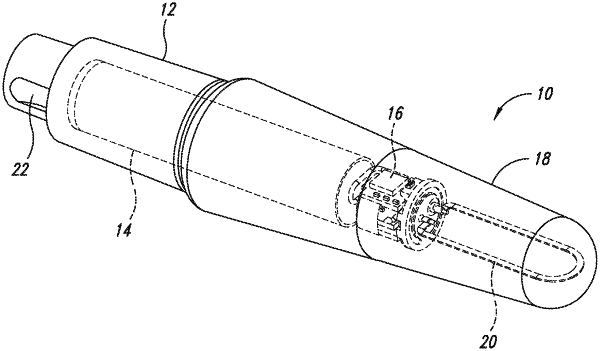| CPC A61F 2/468 (2013.01) [A61B 5/0004 (2013.01); A61B 5/076 (2013.01); A61B 5/4504 (2013.01); A61B 5/4851 (2013.01); A61B 5/686 (2013.01); A61B 5/6878 (2013.01); A61F 2/30721 (2013.01); A61F 2/482 (2021.08); G06Q 40/08 (2013.01); G16H 20/10 (2018.01); G16H 20/30 (2018.01); G16H 20/40 (2018.01); G16H 40/67 (2018.01); H04W 12/037 (2021.01); H04W 84/18 (2013.01); H04W 88/08 (2013.01); A61B 5/112 (2013.01); A61B 2562/0219 (2013.01); A61F 2/12 (2013.01); A61F 2/24 (2013.01); A61F 2002/30331 (2013.01); A61F 2002/30507 (2013.01); A61F 2002/3067 (2013.01); A61F 2002/30884 (2013.01); A61F 2/30942 (2013.01); A61F 2002/30985 (2013.01); A61F 2/32 (2013.01); A61F 2/389 (2013.01); A61F 2/40 (2013.01); A61F 2250/0002 (2013.01); A61F 2250/0096 (2013.01); H04L 67/12 (2013.01)] | 21 Claims |

|
1. An implantable prosthesis, comprising:
a housing; and
an implantable circuit disposed in the housing and comprising a sensor, the implantable circuit configured to:
generate a signal representative of a movement, the signal generated at a fixed sampling rate and comprising acceleration signals relative to a coordinate system of the sensor and angular velocity signals relative to the coordinate system of the sensor;
compare a high output data rate version of the signal to a corresponding benchmark signal comprising acceleration signals relative to the coordinate system of the sensor and angular velocity signals relative to the coordinate system of the sensor to determine whether the signal meets a first criterion; and
send the signal to a remote location in response to determining that the signal meets the first criterion.
|